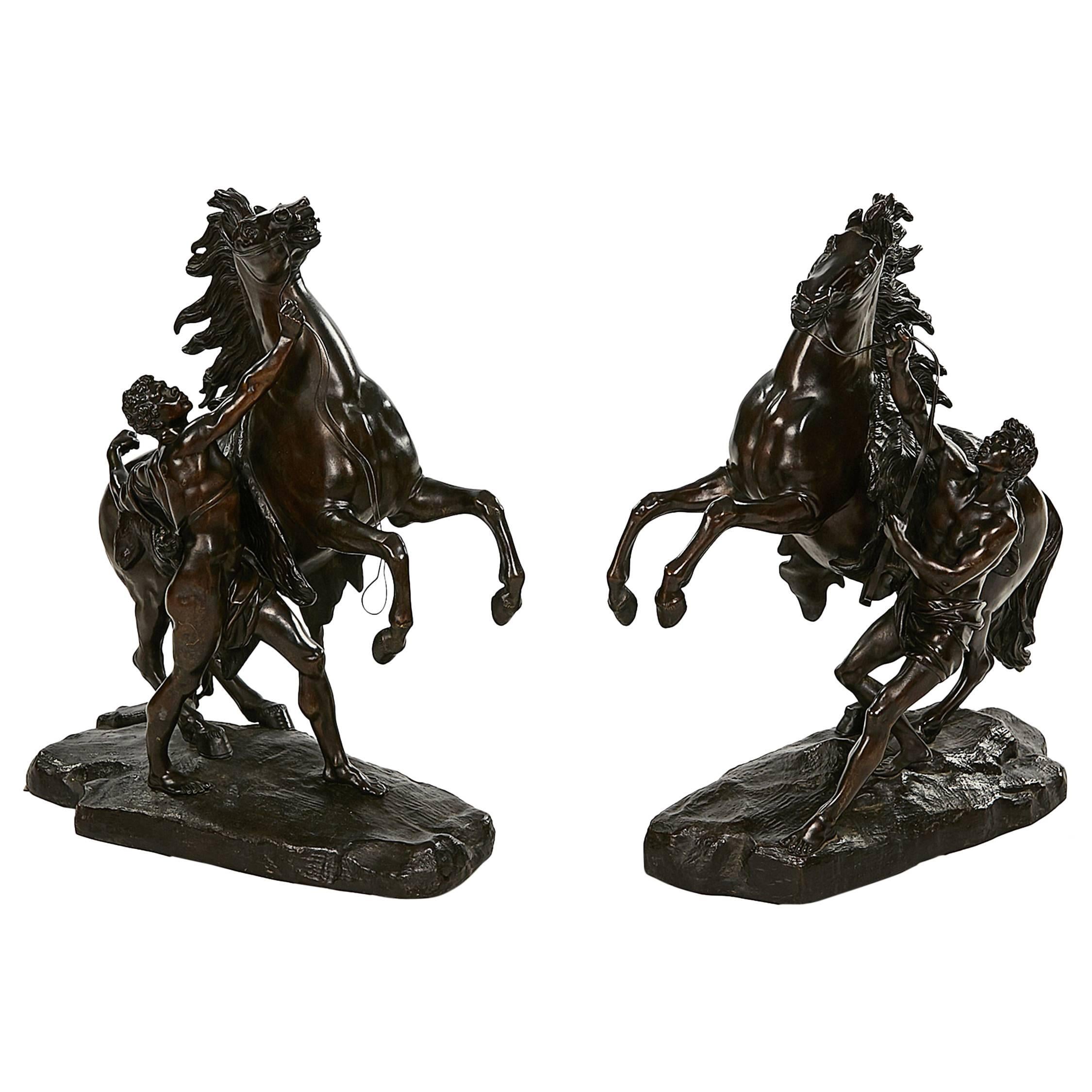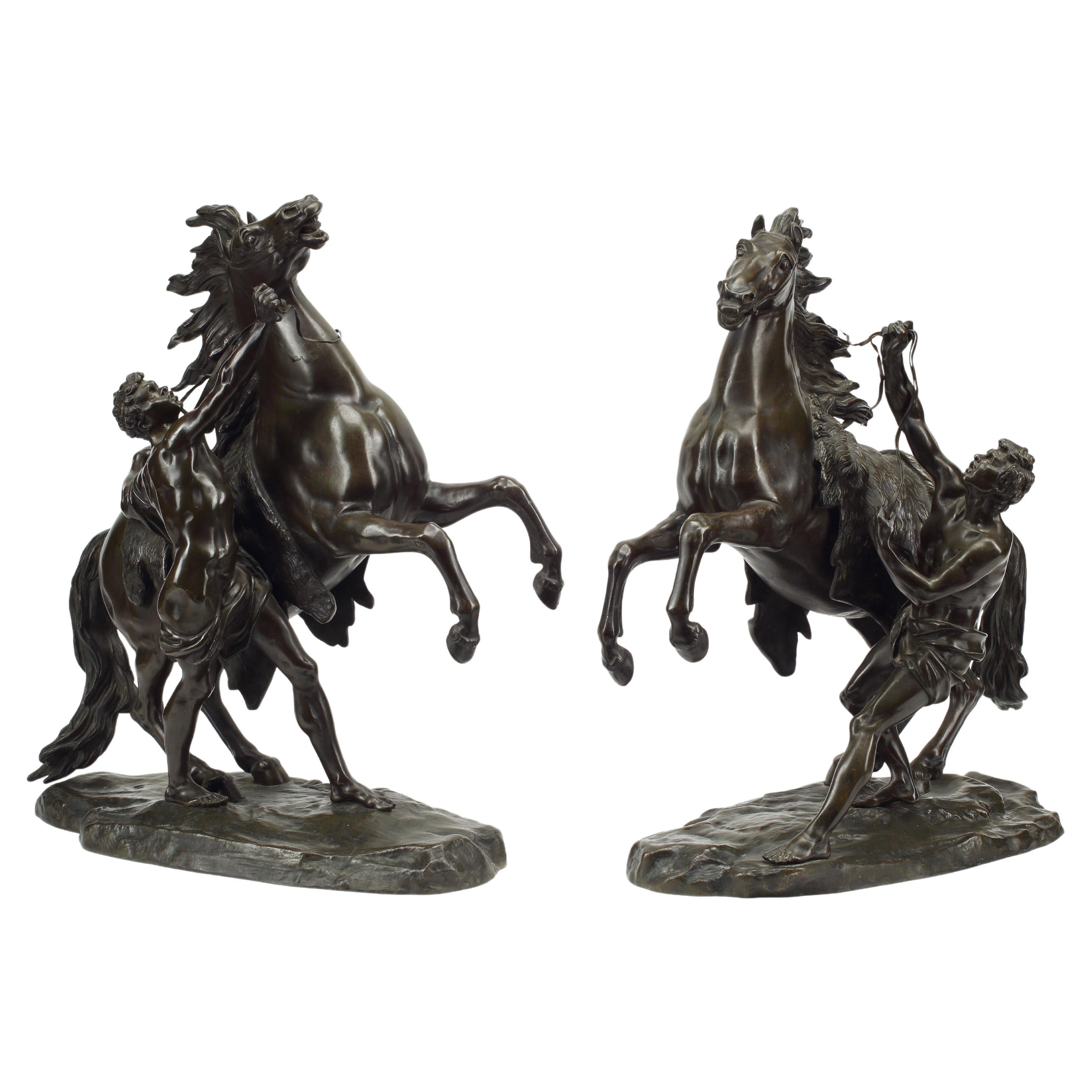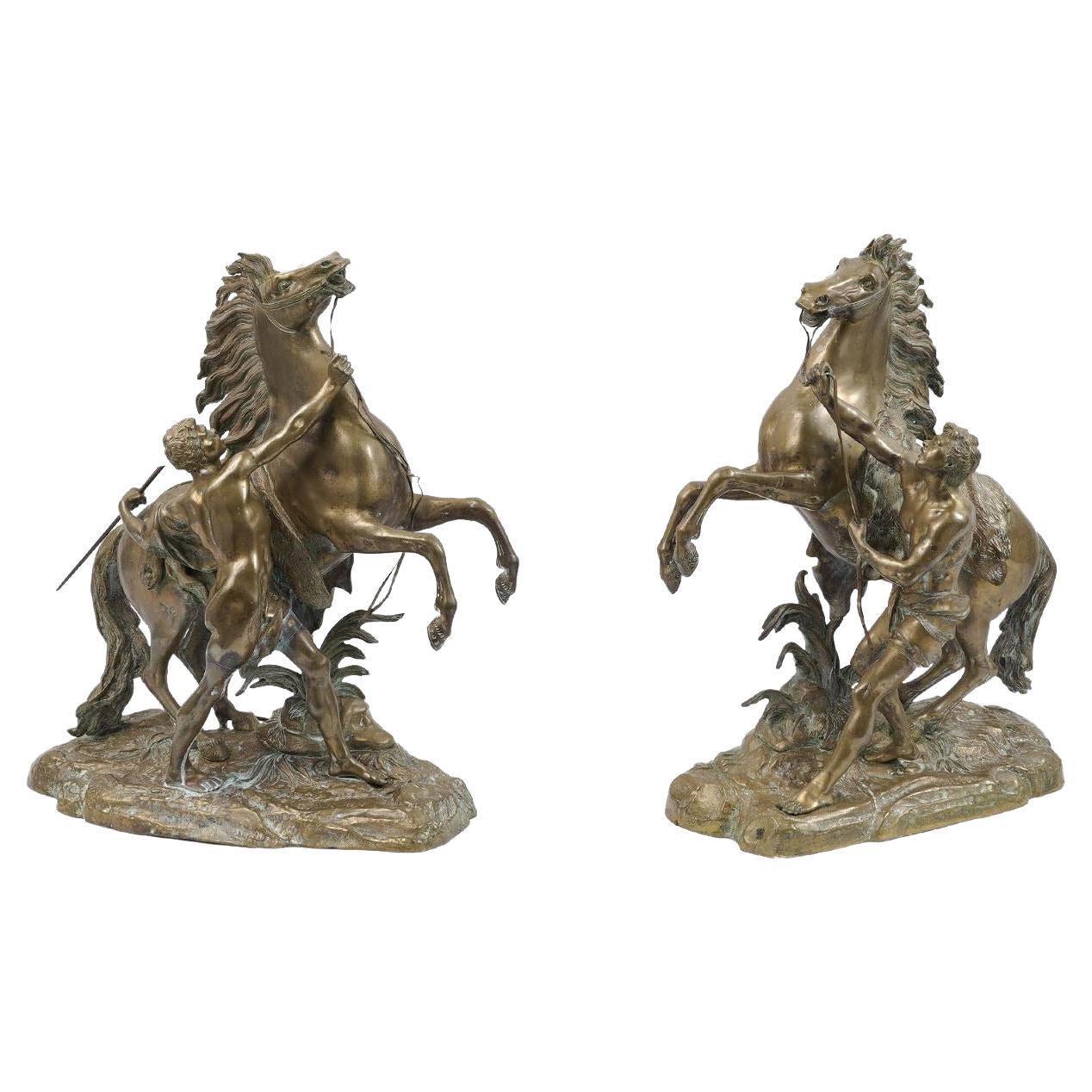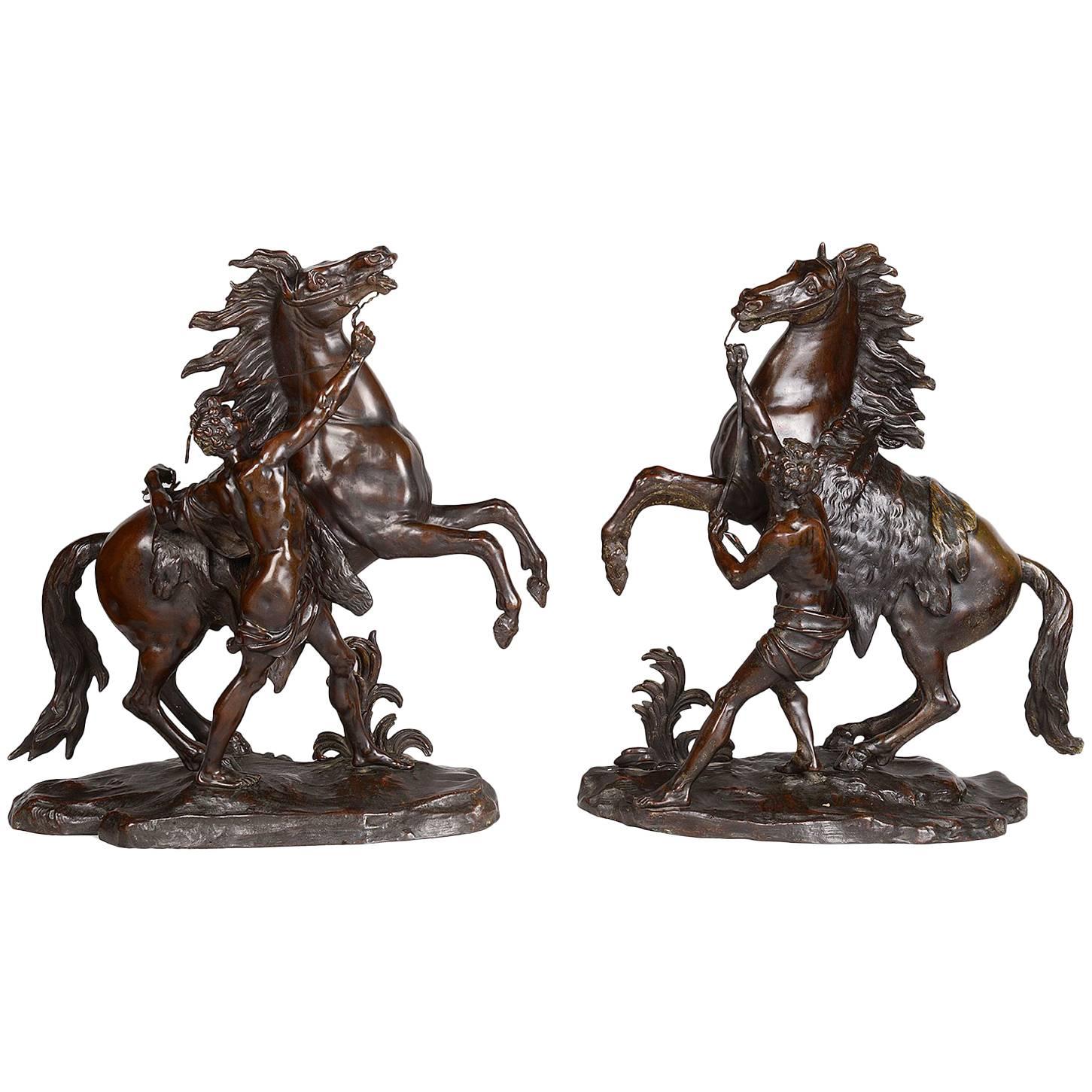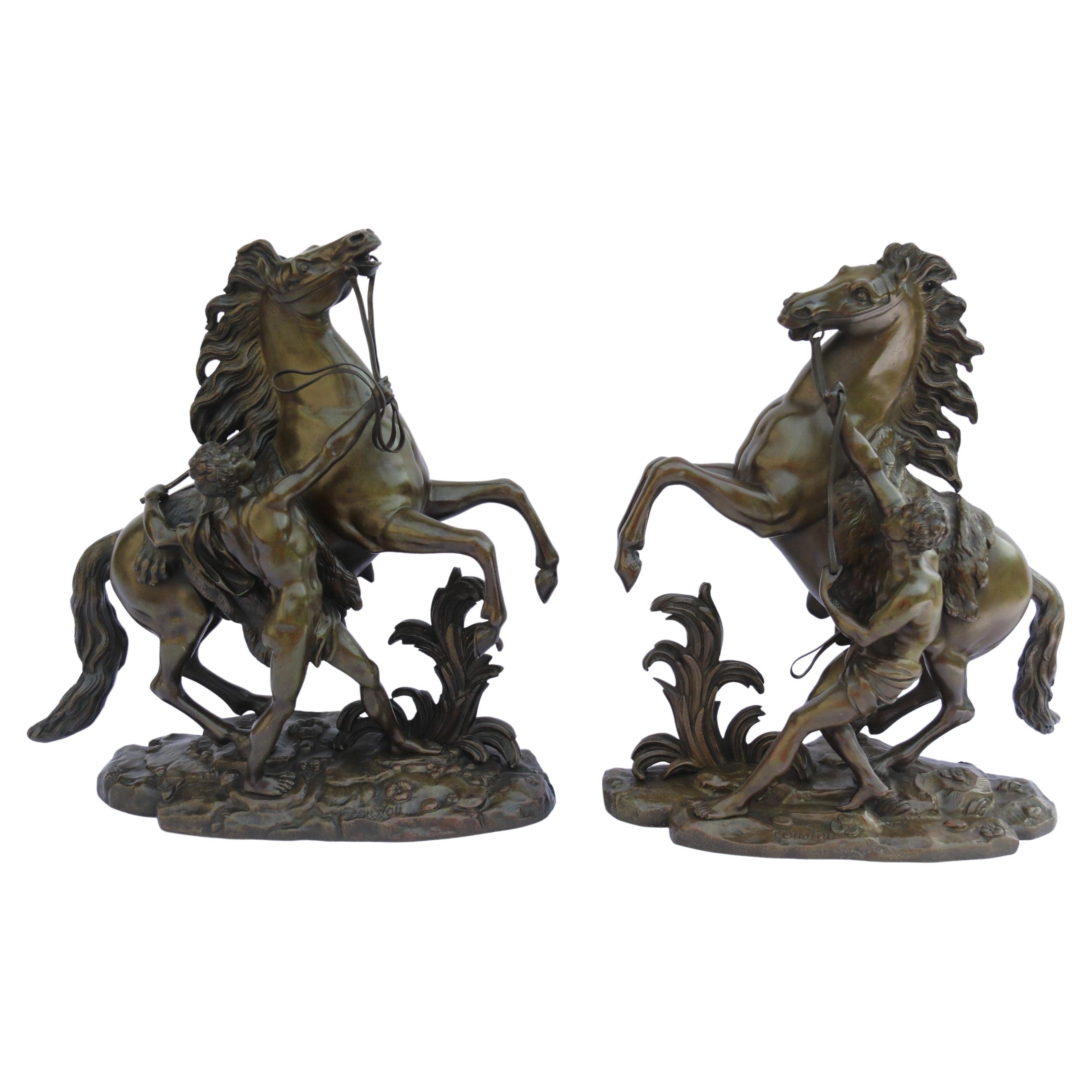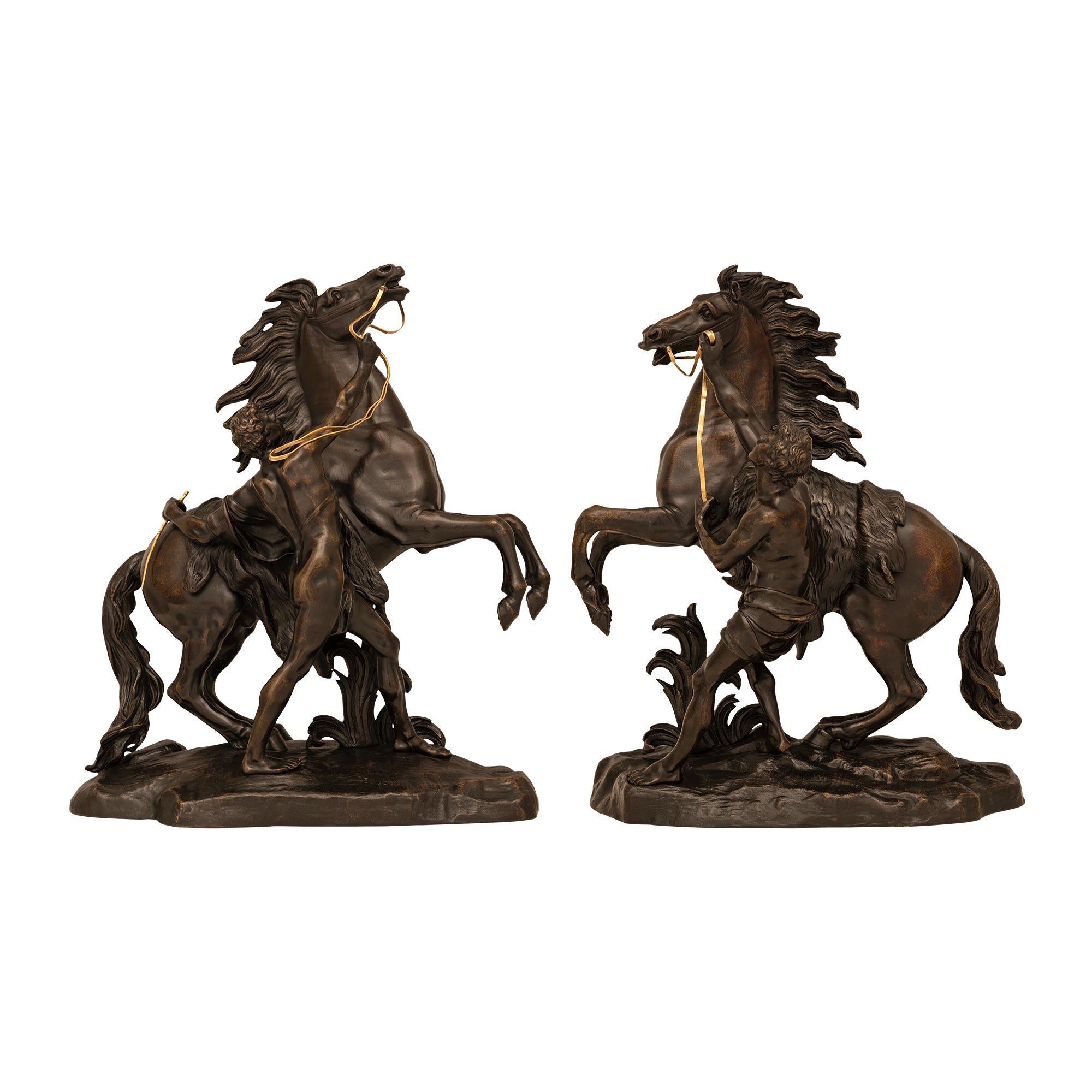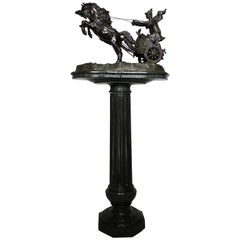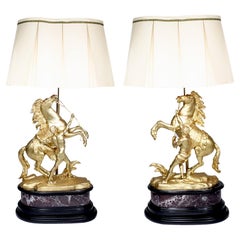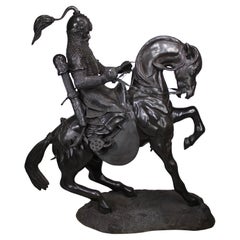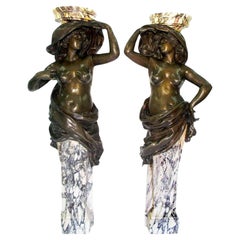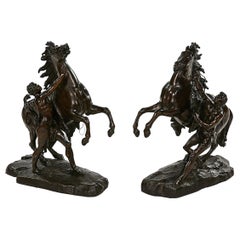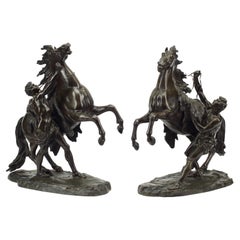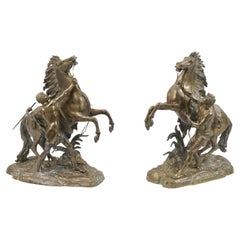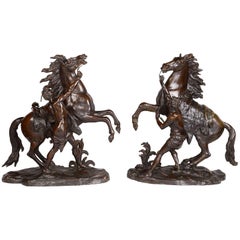Items Similar to Pair of French 19th/20th Century Patinated Bronze Sculptures "The Marly Horses"
Video Loading
Want more images or videos?
Request additional images or videos from the seller
1 of 18
Pair of French 19th/20th Century Patinated Bronze Sculptures "The Marly Horses"
$18,950per set
£14,390.17per set
€16,484.12per set
CA$26,909.62per set
A$29,435.05per set
CHF 15,389.38per set
MX$354,553.49per set
NOK 192,345.93per set
SEK 181,451.37per set
DKK 123,052.13per set
About the Item
A Fine Pair of French 19th/20th Century Patinated Bronze Sculptures of "The Marly Horses" After the original by Guillaume Coustou (French, 1677-1746). The large pair of equestrian bronze sculptures, finished in a dark-brown patina, each depicting rearing horses with their groom. Each signed on base 'Coustou'. Circa: Paris, 1900-1920.
Height: 23 inches (58.4 cm)
Width: 22 inches (55.9 cm)
Base Depth: 11 inches (27.9 cm)
The original Marly Horses are two 1743–1745 Carrara marble sculpted groups by Guillaume Coustou. They were commissioned by Louis XV of France for the trough at the entrance to the grounds of his château de Marly. Coustou's last works, they were intended to replace two other sculpted groups, Mercury on Pegasus and Pegasus, Renown of Horses, both by Antoine Coysevox, which had been removed to the Tuileries Gardens in 1719.
Louis XV chose the modellos in 1743 and the full-size sculptures were completed in only two years, being installed at Marly in 1745. They proved highly successful in reproduction, particularly on a smaller scale, and prefigured Théodore Géricault and other Romantic artists' obsession with equestrian subjects. The Marly horses were later also used as the central motif of the monochrome 819-line RTF/ORTF test card which was used on TF1 from 1953 until 1983.
The originals were moved to the place de la Concorde in Paris in 1794 and Louis-Denis Caillouette (1790–1868) restored them in 1840. In 1984 it was concluded that the annual military parades on 14 July were damaging the sculptures and they were replaced by marble copies produced by Michel Bourbon in the studio of a subsidiary of Bouygues. The latter also gained the right to an extra copy, which was placed in Bouygues's social building. The original sculptures were moved to a former courtyard in the Richelieu wing of the Louvre Museum, which was renamed the 'cour Marly' in their honour, whilst Bourbon's two main copies were moved to the originals' first site near the trough at Marly, with work overseen by the architect Serge Macel.
Guillaume Coustou the Elder (29 November 1677, Lyon – 22 February 1746, Paris) was a French sculptor of the Baroque and Louis XIV style. He was a royal sculptor for Louis XIV and Louis XV and became Director of the Royal Academy of Painting and Sculpture in 1735. He is best known for his monumental statues of horses made for the Chateau of Marly, whose replicas now stand in the Place de la Concorde in Paris.
Coustou was a member of a family of famous sculptors; his uncle, Antoine Coysevox, was a royal sculptor; his elder brother, Nicolas Coustou was a sculptor, and his son Guillaume Coustou the Younger also become a noted royal sculptor. Like his older brother, he won the (Prix de Rome) of the Royal Academy which entitled him to study for four years at the French Academy in Rome. However, he refused to accept the discipline of the academy, gave up his studies, set out to make his own career as an artist. He worked for a time in the atelier of the painter Pierre Legros, and eventually returned to Paris.
Upon his return to Paris, he assisted his uncle Coysevox in making two monumental equestrian sculptures, Fame and Mercury, for the Château de Marly, the new residence of Louis XIV near the Palace of Versailles, where he went to escape the crowds and ceremony of the Palace. He later (1740–1745), made his own horses, The Horses of Marly, his most famous works, to replace them. The horses reinvent the theme of the colossal Roman marbles of the Horse Tamers in the Piazza Quirinale, Rome. They were commissioned by Louis XV in 1739 and installed in 1745 at the Abreuvoir ("Horse Trough") at Marly. The horses were considered masterpieces of the grace and expressiveness of the French Late Baroque or Rococo style. After the Revolution they were moved from Marly to the beginning of the Champs-Élysées on the Place de la Concorde. The originals were brought indoors for protection at the Louvre Museum in 1984.
In 1704 Coustou was received into the Académie royale de peinture et de sculpture. The work he made to mark his entrance was Hercules on the Pyre, now in the Louvre. It displays the special hallmark of the Baroque, a twisting and rising transverse pose, as well as highly skillful carving. He rose to become Director of the academy in 1733.
Another of his major works from his later career, the statue of Maria Leszczynska, (1731)is on display at the Louvre.
Coustou also created two colossal monuments, The Ocean and the Mediterranean among other sculptures for the park at Marly; the bronze Rhone, which formed part of the statue of Louis XIV at Lyons, and the sculptures at the entrance of the Hôtel des Invalides. Of these latter, the bas-relief representing Louis XIV mounted and accompanied by Justice and Prudence was destroyed during the Revolution, but was restored in 1815 by Pierre Cartellier from Coustou's model; the bronze figures of Mars and Minerva (1733–34), on either side of the doorway, were not interfered with.
In 1714 for Marly he collaborated in two marble sculptures representing Apollo Chasing Daphne (both at the Louvre), in which Nicolas Coustou sculpted the Apollo and Guillaume the Daphne. About the same time he was commissioned to produce another running figure in marble, a Hippomenes designed to complement an Atalanta copied from the Antique by Pierre Lepautre: each was placed at the center of one of the carp pools at Marly.
In 1725 the duc d'Antin, general director of the Bâtiments du Roi commissioned a pair of life-size marbles of Louis XV as Jupiter and Marie Leszczynska as Juno for the park of his château de Petit-Bourg, which adjoined the park of Versailles, to which it was added after the duke's death.
A number of his sculptures were for the Tuileries Gardens, most notably a bronze Diane à la biche ("Diana and a Deer"), and Hippoméne (1714), which was originally in the goldfish pond at Marly, then moved to the Tuileries until 1940, when it was brought into the Louvre.
Coustou's marble Bust of Samuel Bernard is at the Metropolitan Museum of Art, Guillaume often worked with his brother Nicolas Coustou, particularly in the decoration of royal domestic architecture at Versailles.
Sculpture
Hercules on the pyre, (1704), the Louvre
Hercules on the pyre, (1704), the Louvre
Study for one of the horses of Marly (Metropolitan Museum)
Study for one of the horses of Marly (Metropolitan Museum)
One of the Chevaux de Marly
One of the Chevaux de Marly
Daphne chased by Apollo, Louvre
Daphne chased by Apollo, Louvre
Allegory of the Rhone River, Lyon
Allegory of the Rhone River, Lyon
Marie Leszczynska, the Louvre
Marie Leszczynska, the Louvre
Hippomène, Tuileries Garden
Hippomène, Tuileries Garden
Summer from The Four Seasons, originally at Marly, now in Tuileries Gardens
Summer from The Four Seasons, originally at Marly, now in Tuileries Gardens
Bust of Samuel Bernard
- Similar to:Guillaume Coustou (Sculptor)
- Dimensions:Height: 23 in (58.42 cm)Width: 22 in (55.88 cm)Depth: 9.25 in (23.5 cm)
- Sold As:Set of 2
- Style:Louis XV (In the Style Of)
- Materials and Techniques:Bronze,Patinated
- Place of Origin:
- Period:1900-1909
- Date of Manufacture:Circa: Paris, 1900-1920
- Condition:A truly beautiful pair of sculptures. Overall condition is very good with minor wear to the patina. Please view all images.
- Seller Location:Los Angeles, CA
- Reference Number:Seller: Ref.: A28681stDibs: LU1796246106032
About the Seller
5.0
Vetted Professional Seller
Every seller passes strict standards for authenticity and reliability
Established in 1982
1stDibs seller since 2016
135 sales on 1stDibs
Typical response time: 1 hour
- ShippingRetrieving quote...Shipping from: Los Angeles, CA
- Return Policy
Authenticity Guarantee
In the unlikely event there’s an issue with an item’s authenticity, contact us within 1 year for a full refund. DetailsMoney-Back Guarantee
If your item is not as described, is damaged in transit, or does not arrive, contact us within 7 days for a full refund. Details24-Hour Cancellation
You have a 24-hour grace period in which to reconsider your purchase, with no questions asked.Vetted Professional Sellers
Our world-class sellers must adhere to strict standards for service and quality, maintaining the integrity of our listings.Price-Match Guarantee
If you find that a seller listed the same item for a lower price elsewhere, we’ll match it.Trusted Global Delivery
Our best-in-class carrier network provides specialized shipping options worldwide, including custom delivery.More From This Seller
View AllItalian 19th Century Bronze Sculpture Group of a Two-Horse Roman Chariot & Rider
Located in Los Angeles, CA
A fine and large Italian 19th century Greco Roman style brown patinated bronze sculpture group of a two-horse Roman Chariot and rider in a dark patina, raised on a fitted Verde d'alp...
Category
Antique 19th Century Italian Greco Roman Figurative Sculptures
Materials
Marble, Bronze
$12,950 Sale Price
22% Off
Pair French 19th/20th Century Gilt-Bronze Sculptures of The Marly Horses Lamps
By Guillaume Coustou
Located in Los Angeles, CA
A Fine Pair of French 19th/20th Century Gilt-Bronze Sculptures of "The Marly Horses" (Now turned into lamps) After the original by Guillaume Coustou (French, 1677-1746). The large pair of equestrian bronze sculptures, finished in a gold patina, each depicting rearing horses with their groom, both raised on oval a black slate and Bardiglio marble bases and fitted with modern electrical twin-light brass fittings and cream colored shades. The base on an ebonized wooden platform. Circa: Paris, 1900-1920.
Sculpture & Base Height: 31 1/4 inches (79.8 cm)
Base Width: 21 3/4 inches (55.3 cm)
Base Depth: 12 3/4 inches (32.4 cm)
Height to top of (Adjustable) shade fitting: 48 1/4 inches (122.6 cm)
Shade Height: 15 inches (38.1 cm)
Shade Width: 26 inches (66.1 cm)
Shade Depth: 20 inches (50.8 cm)
The original Marly Horses are two 1743–1745 Carrara marble sculpted groups by Guillaume Coustou. They were commissioned by Louis XV of France for the trough at the entrance to the grounds of his château de Marly. Coustou's last works, they were intended to replace two other sculpted groups, Mercury on Pegasus and Pegasus, Renown of Horses, both by Antoine Coysevox, which had been removed to the Tuileries Gardens in 1719.
Louis XV chose the modellos in 1743 and the full-size sculptures were completed in only two years, being installed at Marly in 1745. They proved highly successful in reproduction, particularly on a smaller scale, and prefigured Théodore Géricault and other Romantic artists' obsession with equestrian subjects. The Marly horses were later also used as the central motif of the monochrome 819-line RTF/ORTF test card which was used on TF1 from 1953 until 1983.
The originals were moved to the place de la Concorde in Paris in 1794 and Louis-Denis Caillouette (1790–1868) restored them in 1840. In 1984 it was concluded that the annual military parades on 14 July were damaging the sculptures and they were replaced by marble copies produced by Michel Bourbon in the studio of a subsidiary of Bouygues. The latter also gained the right to an extra copy, which was placed in Bouygues's social building. The original sculptures were moved to a former courtyard in the Richelieu wing of the Louvre Museum, which was renamed the 'cour Marly' in their honour, whilst Bourbon's two main copies were moved to the originals' first site near the trough at Marly, with work overseen by the architect Serge Macel.
Guillaume Coustou the Elder (29 November 1677, Lyon – 22 February 1746, Paris) was a French sculptor of the Baroque and Louis XIV style. He was a royal sculptor for Louis XIV and Louis XV and became Director of the Royal Academy of Painting and Sculpture in 1735. He is best known for his monumental statues of horses made for the Chateau of Marly, whose replicas now stand in the Place de la Concorde in Paris.
Coustou was a member of a family of famous sculptors; his uncle, Antoine Coysevox, was a royal sculptor; his elder brother, Nicolas Coustou was a sculptor, and his son Guillaume Coustou the Younger also become a noted royal sculptor. Like his older brother, he won the (Prix de Rome) of the Royal Academy which entitled him to study for four years at the French Academy in Rome. However, he refused to accept the discipline of the academy, gave up his studies, set out to make his own career as an artist. He worked for a time in the atelier of the painter Pierre Legros, and eventually returned to Paris.
Upon his return to Paris, he assisted his uncle Coysevox in making two monumental equestrian sculptures, Fame and Mercury, for the Château de Marly, the new residence of Louis XIV near the Palace of Versailles, where he went to escape the crowds and ceremony of the Palace. He later (1740–1745), made his own horses, The Horses of Marly, his most famous works, to replace them. The horses reinvent the theme of the colossal Roman marbles of the Horse Tamers in the Piazza Quirinale, Rome. They were commissioned by Louis XV in 1739 and installed in 1745 at the Abreuvoir ("Horse Trough") at Marly. The horses were considered masterpieces of the grace and expressiveness of the French Late Baroque or Rococo style. After the Revolution they were moved from Marly to the beginning of the Champs-Élysées on the Place de la Concorde. The originals were brought indoors for protection at the Louvre Museum in 1984.
In 1704 Coustou was received into the Académie royale de peinture et de sculpture. The work he made to mark his entrance was Hercules on the Pyre, now in the Louvre. It displays the special hallmark of the Baroque, a twisting and rising transverse pose, as well as highly skillful carving. He rose to become Director of the academy in 1733.
Another of his major works from his later career, the statue of Maria Leszczynska, (1731)is on display at the Louvre.
Coustou also created two colossal monuments, The Ocean and the Mediterranean among other sculptures for the park at Marly; the bronze Rhone, which formed part of the statue of Louis XIV at Lyons, and the sculptures at the entrance of the Hôtel des Invalides. Of these latter, the bas-relief representing Louis XIV mounted and accompanied by Justice and Prudence was destroyed during the Revolution, but was restored in 1815 by Pierre Cartellier from Coustou's model; the bronze figures of Mars and Minerva (1733–34), on either side of the doorway, were not interfered with.
In 1714 for Marly he collaborated in two marble sculptures representing Apollo Chasing Daphne (both at the Louvre), in which Nicolas Coustou sculpted the Apollo and Guillaume the Daphne. About the same time he was commissioned to produce another running figure in marble, a Hippomenes designed to complement an Atalanta copied from the Antique by Pierre Lepautre...
Category
Antique Early 1900s French Louis XV Animal Sculptures
Materials
Marble, Bronze
A Monumental Bronze Sculpture of "Tartar Warrior Checking His Horse" after Barye
By Antoine-Louis Barye
Located in Los Angeles, CA
A Monumental Equestrian Patinated Bronze Group Sculpture of "Tartar Warrior Checking His Horse" after the original model by Antoine Louis Barye (French, 1795-1875). The large and hea...
Category
Late 20th Century Unknown Islamic Figurative Sculptures
Materials
Bronze
$10,325 Sale Price
30% Off
A Pair French 19th Century Bronze Nude Maidens Torchere, Carrier-Belleuse Attr.
By Albert-Ernest Carrier-Belleuse
Located in Los Angeles, CA
Very fine and monumental pair of French 19th century patinated bronze figural torchere sculptures titled "La Nuit" (The Night) attributed to Albert Carrier-Belleuse (French, 1824-188...
Category
Antique Late 19th Century French Beaux Arts Figurative Sculptures
Materials
Marble, Bronze
Pair of French 19th Century Louis XV Style Gilt and Silvered Bronze Chenets
Located in Los Angeles, CA
A fine pair of French 19th century Louis XV style figural gilt bronze and silver plated bronze chenets, each surmounted by a triton blowing a seashell Horn, resting on a pierced roca...
Category
Antique Late 19th Century French Louis XV Andirons
Materials
Bronze
$6,845 Sale Price / set
63% Off
Pair of French Early 19th Century Louis XV Style Gilt Bronze Andirons Chenets
Located in Los Angeles, CA
A pair of French Early 19th century Louis XV gilt bronze figural Chenets Andirons. The scrolled and pierced body, each surmounted with a figure of a young boy and a young girl, both ...
Category
Antique Early 19th Century French Louis XV Figurative Sculptures
Materials
Bronze
$2,895 Sale Price
31% Off
You May Also Like
Pair of 19th Century French Patinated Bronze Models of the Marly Horses
By Guillaume Coustou
Located in Long Island City, NY
Pair of 19th century French patinated bronze models of the Marly Horses.
Category
Antique 1870s French Napoleon III Figurative Sculptures
Materials
Bronze
Pair of Patinated Bronze Marly Horse Sculptures, 19th Century French
Located in El Monte, CA
A pair of 19th century patinated bronze sculptures following the renowned "Marly Horses" created by celebrated baroque sculpture Guillaume Coustou. This pair is inscribed "Coustou" o...
Category
Antique 19th Century French Animal Sculptures
Materials
Bronze
Pair 19th Century French Bronze Marly Horse Sculptures After Coustou
By Guillaume Coustou
Located in New York, NY
Pair of 19th century French bronze marly horse statues after the original models by Guillaume Coustou (1677-1746).
Category
Antique Late 19th Century French Neoclassical Figurative Sculptures
Materials
Marble, Bronze
Large Pair of 19th Century Bronze Marly Horses, after Coustou
By Coustou
Located in Brighton, Sussex
A very impressive pair of 19th century bronze Marly horse, having a good patina, after Guillaume Coustou the elder 1677-1746.
Category
Antique 19th Century French Animal Sculptures
Materials
Bronze
Large Pair of French 19th Century Bronze Marly Horses After Costou, circa 1870
By Guillame Costou
Located in Central England, GB
This fantastic pair of 19th century finely sculpted, large scale bronze figures are after Guillaume Costou (1677 – 1746. )They each depict a wild prancing horse being restrained by t...
Category
Antique 1870s French Louis Philippe Animal Sculptures
Materials
Bronze
True Pair Of French 19th Century Patinated Bronze Marly Horse Statues
By Guillaume Coustou
Located in West Palm Beach, FL
A most impressive and large scale true pair of French 19th century patinated Bronze Marly horse statues, after a model by Coustou. Each statue is raised on a rock and ground like des...
Category
Antique 19th Century French Animal Sculptures
Materials
Bronze, Ormolu
More Ways To Browse
Antique Minerva
Antique Marbles
The Four Seasons 19th Century
Coustou Bronze
Life Size Bronze Horse Statues
Bronze Marly Horses
Marly Horse Sculptures
Antique French Bronze Horse
Coustou Bronze Marly Horse
Mars And Minerva
Antique French Baroque Rococo Style
Bronze Minerva
Antoine Coysevox
Erik Hoglund Glass Sculpture
Eugene Blot
Eugene Delaplanche
Faux Marble Plinth
Female Mannequin Used Mannequins
